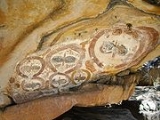
Wondjina
Encyclopedia

Cloud
A cloud is a visible mass of liquid droplets or frozen crystals made of water and/or various chemicals suspended in the atmosphere above the surface of a planetary body. They are also known as aerosols. Clouds in Earth's atmosphere are studied in the cloud physics branch of meteorology...
and rain
Rain
Rain is liquid precipitation, as opposed to non-liquid kinds of precipitation such as snow, hail and sleet. Rain requires the presence of a thick layer of the atmosphere to have temperatures above the melting point of water near and above the Earth's surface...
spirits who, during the Dream time, created or influenced the landscape and its inhabitants. When they found the place they would die, they painted their images on cave
Cave
A cave or cavern is a natural underground space large enough for a human to enter. The term applies to natural cavities some part of which is in total darkness. The word cave also includes smaller spaces like rock shelters, sea caves, and grottos.Speleology is the science of exploration and study...
walls and entered a nearby waterhole.
Today, certain Aboriginal people of the Mowanjum tribes repaint the images to ensure the continuity of the Wondjina's presence.
Annual repainting in December or January also ensures the arrival of the monsoon rains, according to Mowanjum belief. Repainting has occurred so often that at one site the paint is over 40 layers deep. The painting style evolves during this process: the figures of recent years are stockier and some now possess eyelashes.
The Wondjina paintings have common colors of black, red and yellow on a white background. They appear alone or in groups, vertically or horizontally depending on the dimensions of the rock, and can be depicted with figures and objects like the Rainbow Serpent
Rainbow Serpent
The Rainbow Serpent is a common motif in the art and mythology of Aboriginal Australia. It is named for the snake-like meandering of water across a landscape and the colour spectrum caused when sunlight strikes water at an appropriate angle relative to the observer.The Rainbow Serpent is seen as...
or yams
Yam (vegetable)
Yam is the common name for some species in the genus Dioscorea . These are perennial herbaceous vines cultivated for the consumption of their starchy tubers in Africa, Asia, Latin America and Oceania...
. Common composition is with large upper bodies and heads that show eyes and nose, but typically no mouth. Two explanations have been given for this: they are so powerful they do not require speech and if they had mouths, the rain would never cease. Around the heads of Wondjina are lines or blocks of color, depicting lightning, clouds or rain. The Wondjina can punish those who break the law with floods, lightning and cyclones. The paintings are still believed to possess these powers and therefore are to be approached and treated respectfully. Each site and painting has a name.
In 2007, graffiti
Graffiti
Graffiti is the name for images or lettering scratched, scrawled, painted or marked in any manner on property....
depictions of Wandjina appeared in Perth
Perth, Western Australia
Perth is the capital and largest city of the Australian state of Western Australia and the fourth most populous city in Australia. The Perth metropolitan area has an estimated population of almost 1,700,000....
, Western Australia
Western Australia
Western Australia is a state of Australia, occupying the entire western third of the Australian continent. It is bounded by the Indian Ocean to the north and west, the Great Australian Bight and Indian Ocean to the south, the Northern Territory to the north-east and South Australia to the south-east...
. Styles ranged from stencil-work to a spray painted Wondjina driving a pink car. Using flickr
Flickr
Flickr is an image hosting and video hosting website, web services suite, and online community that was created by Ludicorp in 2004 and acquired by Yahoo! in 2005. In addition to being a popular website for users to share and embed personal photographs, the service is widely used by bloggers to...
and blogs, several people engaged in 'Wondjina watching', documenting the Wondjina graffiti they found. These 'wandering Wondjina' angered and upset Aboriginals who said that only certain of their people are permitted to depict the Wondjina. A short film, Who Paintin' Dis Wandjina, discussed the Aboriginal reaction.

